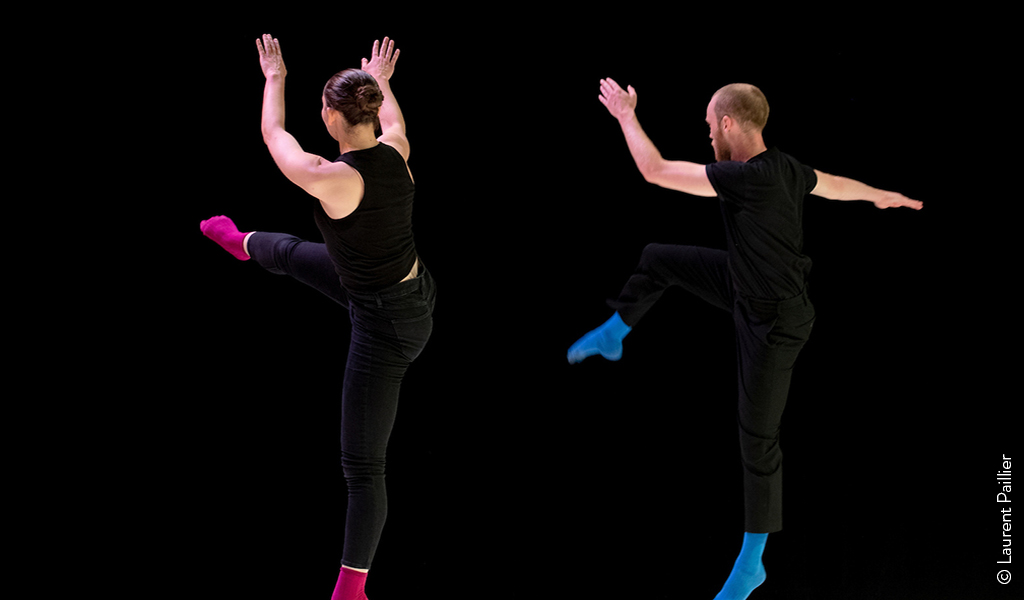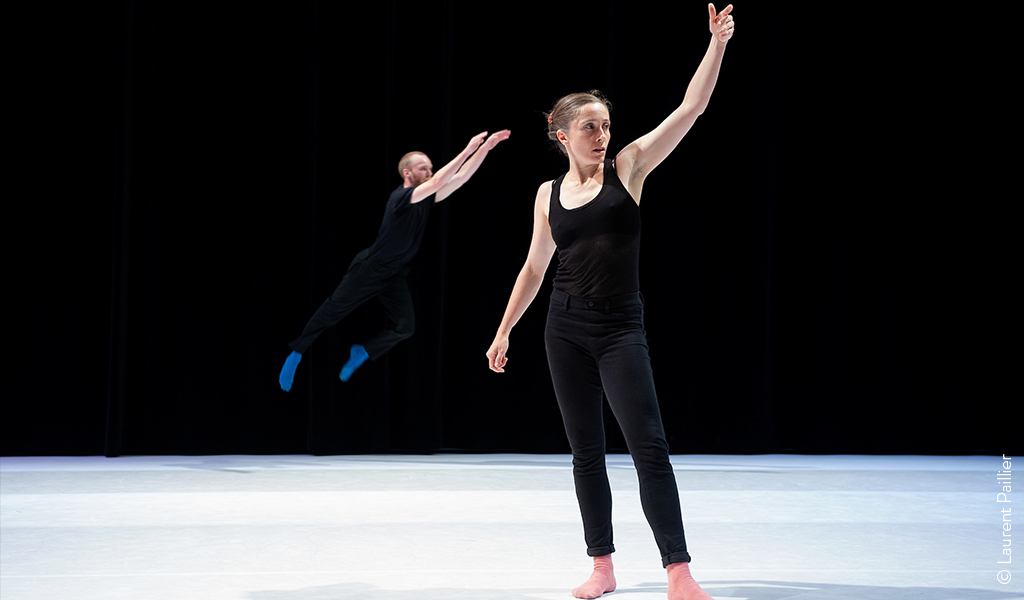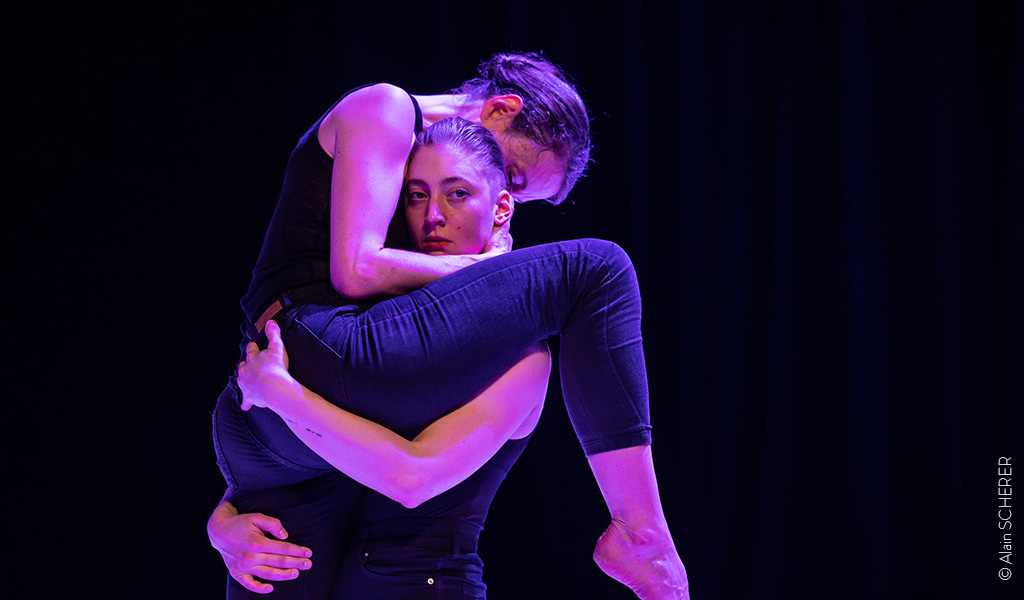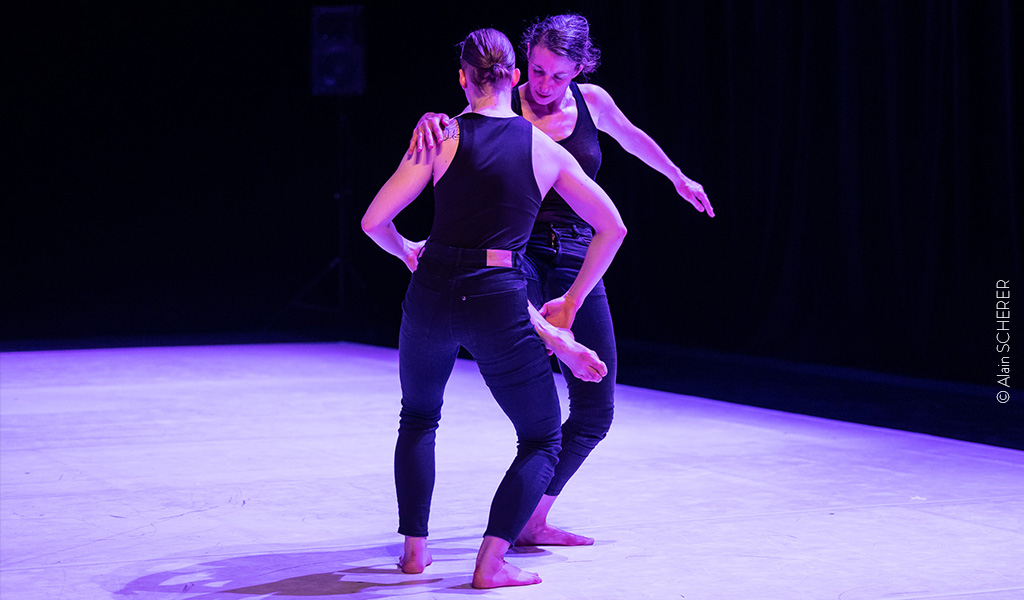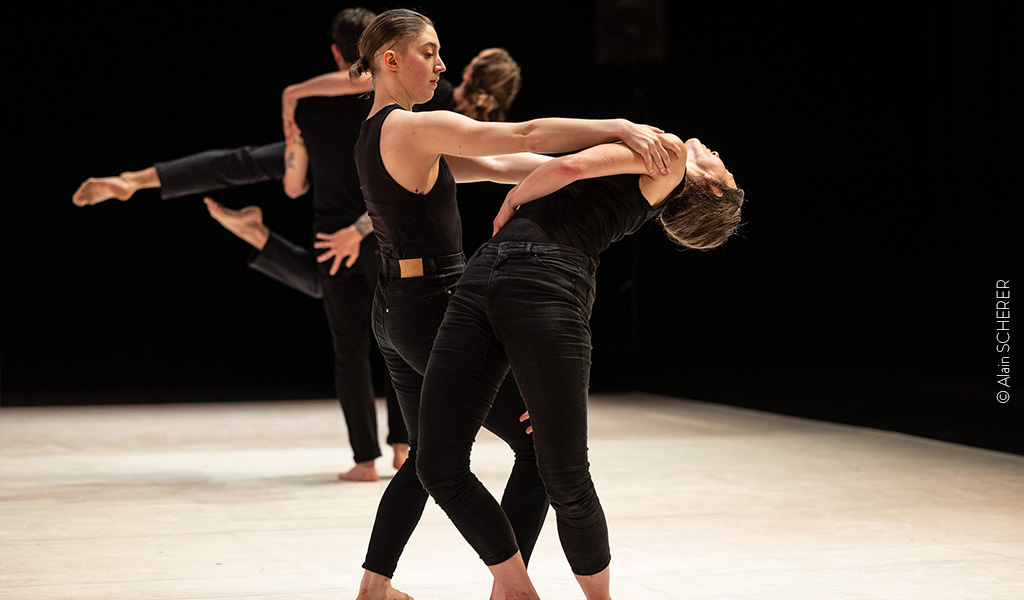WILDER SHORES owes its title to a painting by the American painter Cy Twombly called ‘The wilder shores of love’. Transposed to the project, our “wilder shores” are those of time, space and energy, in other words, those of dance and choreography.
The aspects of Cy Twombly’s work that interest me in particular are twofold: on the one hand, his way of dealing with energy on the canvas, and on the other hand, the idea of drawing his creative force from the past in order to restore it in a current and contemporary form. For Twombly, this past is that of literature and painting, especially from antiquity and classical times. In WILDER SHORES we revisit and use certain figures of classical ballet as well as certain fundamental choreographic principles dear to Merce Cunningham. But in our case, by working with instant composition, – a work process inherent to my choreography and defining it-, we radically modify form and content in our piece. In this manner WILDER SHORES resonates with our times and becomes a contemporary performance, dealing with the present.
In this sense, the WILDER SHORES project is like a conversation. It is constructed in dialogue with the work of several artists and thinkers, including Cy Twombly, drawing on the past to create the present. Its subject – if one can speak of a subject outside of the choreographic question – is this imaginary conversation between living and dead artists and researchers, in resonance with the world and current artistic questions.
ARTISTIC DIRECTION, CONCEPT: MICHELE MURRAY
ARTISTIC COLLABORATION: MAYA BROSCH, MARIE LECA
PERFORMERS: ALEXANDRE BACHELARD, LÉO GRAS alternating with MARIE LECA, VIVIEN KOVARBASIC, BAPTISTE MENARD, MANUEL MOLINO, LÉA VINETTE ( Premiere performed with REBECCA JOURNO, FELIX MAURIN, DEBORAH PAIRETTI)
MUSIC: GEROME NOX
LIGHTS: CATHERINE NODEN
PARTNERS
PRODUCTION: ASSOCIATION STELLA
COPRODUCTION: FESTIVAL MONTPELLIER DANSE 2020 / LA PLACE DE LA DANSE – CENTRE DE DÉVELOPPEMENT CHORÉGRAPHIQUE NATIONAL DE TOULOUSE / CENTRE CHORÉGRAPHIQUE NATIONAL DE TOURS – DIRECTION THOMAS LEBRUN / ICI – CENTRE CHORÉGRAPHIQUE NATIONAL DE MONTPELLIER OCCITANIE – DIRECTION CHRISTIAN RIZZO / LA MAISON – CENTRE DE DÉVELOPPEMENT CHORÉGRAPHIQUE UZES GARD OCCITANIE / EMMETROP ANTREPEAUX BOURGES / POLE DE DEVELOPPEMENT CHOREGRAPHIQUE MONTPELLIER MOSSON – DIRECTION DIDIER THERON / SUPPORTED BY FONDOC
WORK RESIDENCIES: LA PLACE DE LA DANSE – CENTRE DE DÉVELOPPEMENT CHORÉGRAPHIQUE NATIONAL DE TOULOUSE / CENTRE CHORÉGRAPHIQUE NATIONAL DE TOURS – DIRECTION THOMAS LEBRUN / MONTPELLIER DANSE – AGORA, CITE INTERNATIONALE DE LA DANSE / ICI – CENTRE CHORÉGRAPHIQUE NATIONAL DE MONTPELLIER OCCITANIE – DIRECTION CHRISTIAN RIZZO / POLE DE DÉVELOPPEMENT CHORÉGRAPHIQUE MONTPELLIER MOSSON – ESPACE BENARD GLANDIER – DIRECTION DIDIER THERON / EMMETROP BOURGES / ZENTRUM ZEITGENÖSSISCHER TANZ, HOCHSCHULE FÜR MUSIK UND TANZ KÖLN / THÉÂTRE LA CIGALIÈRE SERIGNAN
PUBLIC PARTNERS: MINISTÈRE DE LA CULTURE – DIRECTION RÉGIONALE DES AFFAIRES CULTURELLES OCCITANIE PYRENEES – MÉDITERRANÉE / LA RÉGION OCCITANIE PYRENEES – MÉDITERRANÉE / LA VILLE DE MONTPELLIER
© Laurent Pailler / © Alain SCHERER
PRESS WILDER SHORES
Danser Canal Historique / Thomas Hahn / September 2020
Montpellier Danse 40 Bis : Creation of ” Wilder Shores ” by Michèle Murray
From Merce Cunningham to Cy Twombly, unpredictable itineraries for seven dancers between desire and discipline.With Michèle Murray, who began her career in New York, in particular with Merce Cunningham, the search for the great Merce finds an enthusiastic response. This is especially true in “Wilder Shores”, in which seven dancers move in a totally open, free, non-hierarchical space which knows neither center nor periphery. A point in space is a point, and that’s it. The dancer can wander wherever he or she wishes, or so it seems.
Wilder Shores? Let’s not try to understand; this title is a utopia, a burning desire, a fantasy inscribed in a painting by Cy Twombly – “Wilder shores of love” – that is better approached through emotions than through forensic analysis.
Michèle Murray’s “Wilder Shores” expresses in equal measure the cleavage between the desire for freedom, as well as the world against which one must rise in order to succeed in regaining one’s own wild essence. The seven dancers provide no evidence of such liberation, and thus this piece remains as enigmatic as Twombly’s painting.
Murray’s new creation primarily benefits dance, not speech, and this is, of course, a wise choice. It is better to bear witness to a shore one wishes to attain than to go wild there. In this logic, “Wilder Shores” distinguishes itself by absolute rigor, implacable precision and infallible discipline. And yet, this precision in writing and execution opens up spaces of freedom, and perhaps even a few skylights to the unexpected. The principle of random choice was important for Merce. In “Wilder Shores”, we encounter what the choreographer calls instantaneous composition, where everything seems to be invented in the moment. Yet nothing is certain for the audience. When two dancers collide, is it an accident or a choreographed event? It’s probably a foreseen possibility, with no obligation to come true.
Some artists choreographed everyday gestures. Cunningham, on the contrary, invented the most improbable movements, to the point of absurdity. His vocabulary is both a toolbox and an invitation to dig deeper and deeper into unexpected approaches. For Michèle Murray, who enjoys stirring up this toolbox, it inspires a plethora of ways to walk: jerky, gliding, knees bent, hands glued to the thighs in order to turn and twirl better…
Everything starts with a first dancer who enters, in blue socks, with his feet turned out, thus indicating that the universe of the great liberator still has its roots in classical dance! But from then on, everything can be transformed, invented.
In their seemingly random crossings of the stage, individuals observe and meet each other, face to face or in parallel, and tune in to one another, during the time needed to charge oneself with shared energy, and then to set off again towards new human adventures. And it works! After a first part where the desire to touch one another does not come true, after a long pause during which the composer Gerome Nox reigns alone on the sound and choreographic space, a couple emerges and launches into a research on the supports offered by the other, supports offered by his / her thighs, bust, back, as if it were a promise towards shores of love. Here the woman can lift the man, and of course be lifted by him. Here too, modalities break free from all tradition. At the end of the performance, everyone ends up together, as if in a dance class, as if to prepare for new adventures, one next time, on shores that they hope will be wilder…
OFFSHORE / Jean Paul GUARINO / 24 SEPTEMBER 2020
We were there, what about you? Montpellier Danse 40 Bis / September 2020After a re-creation followed by a revival, it’s the turn of a 2020 creation. At the Agora Cunningham Studio in Montpellier, the latest dance creation by Michèle Murray – “WILDER SHORES” premiered Wednesday evening. We won’t mention Twombly, whom Michèle Murray refers to in the program to inform us about her position as an artist. The title of the piece, a hint towards the choreographer’s work methods, was chosen above all in order to boost her choreographic writing, and to dig deeper into her demanding artistic course. And it works! From the first moment onwards, a lone dancer appears, who is then joined by a second one, then a third, until seven dancers finds themselves spinning on stage! Seven free electrons, unless they are lost electrons, illuminated by a radical, cold white light made up of white, green and blue. Seven electrons enveloped in a deeply telluric sound, a sound so powerful that one can hear neither their breath nor the landing of their numerous jumps. Here as well, everything works towards enforcing the expressions of silhouettes, of the bodies, and of dance. If in this “first part”, we noted the energy and charisma of the little Jimmy Somerville – the dancer Baptiste Menard in fact -, during the “second part”, a superb dancer duo took place – performed by Marie Leca and Alexandre Bachelard. The stage was bathed in an atmosphere à la Dan Flavin, in a purple hue that Americans love. This ambient purple then turned into a raw blue, undressing the flesh a little more, illuminating the dancers’ beads of sweat. The whole choreography states that this isn’t a duet, and that these two aren’t a couple either, but instead reveals how 1 + 1 in fact equals 1. Because it was him, because it was her. It’s beautiful. The duet is then followed by a quick return to reality, just in order to reassure us or console us, telling us that other encounters, all encounters, are possible. It’s a good thing when it ends well.
L’OEIL D’OLIVIER / Olivier Frégaville-Gratian d’Amore / SEPTEMBER 23, 2020
In her latest piece, the Montpellier based choreographer Michèle Murray has never been so close to the dance of Dominique Bagouet. Presented as part of the Montpellier Dance festival, the day after the re-creation of “So Schnell”, “Wilder Shores” has everything of the young distant cousin. Disturbing similarity! A simple wall of yellow stones separates the Montpellier Cunningham studio from the Agora Theater. While the day before, the dancer Catherine Legrand breathed new life into Dominique Bagouet’s choreography, Michèle Murray, in her own way, explores the choreographic paths between abstraction and the need to anchor her dance and her movements in a more concrete narrative. Inspired by “The wilder shores of love”, a work by the American painter Cy Twombly, the Montpellier-based artist traces her path, stretching time, multiplying unexpected movements, iterative gestures, accompanied by the music of Gerome Nox.
A unique choreographic writing.
Clothed in black costumes contrasting with the white, immaculate floor, seven dancers invade the space. Entering one after the other, disappearing at will, coming back to haunt the stage, they do not keep still. A solo, a duet, each dancer follows his own score. Bodies gauge each other, look for each other and then ignore each other. There is nothing linear about Michèle Murray’s writing. It consists of a multitude of words linked together by a strict grammar. Michèle Murray, who studied at Merce Cunningham’s studio in New York, is interested in movement for movement’s sake. She has one movement following another, at times even overrunning each other. Her choreographic prose, although formal, is abundant.
Play of light.
Enveloping the empty space with bright lights, just as Begoña Garcia Navas does on “So Schnell”, the Montpellier-based choreographer, with the collaboration of Catherine Noden, highlights her dancers’ bodies, the energy they deploy in order to inhabit the space and give life to these imaginary shores hovering on the border between dreams and reality. With “Wilder Shores”, Michèle Murray has created a piece that is more complex than it seems. However, it still lacks a little polish and practice to totally carry away and seduce. A show in the making!TOUTE LA CULTURE / Antoine COUDER / June 17, 2021 / Festival Uzes Danse / Wilder Shores (of love)
The audience was not mistaken, the choreography “Wilder Shores” could be a dance classic, in its particular way of padlocking space, of working with “strict choreographic rules and a dedicated vocabulary” enabling the irrigation of the choreography and ensuring holding the distance during the whole creation phase. These necessary constraints and rules educate the dancers in this foreign language which is the nascent choreography. They create a basic movement register from which they will begin their conversation, and build connections between each other. By the end of the rehearsal phase, while maintaining its essence, the piece will be able to evolve during each iteration, from the smallest to the biggest improvised movement. Choreographer Michèle Murray requires and makes sure that the performance is sifted through her creative imperatives. One of these imperatives is the distant memory of a painting by Cy Twombly. It might be useful to look at it, in order to access the scope of this romanticism of the frontiers of forms that one perceives here almost instantaneously.
Metal machine Box
In this three-part performance, a dance sextet is projected into a brutal and continuous musical deflagration, a high-pitched vortex that hardly surprises, as one quickly sinks into it along with the dancers, under the live control of Gerome Nox, the composer. Nox seems to have kneaded Lou Reed’s “Metal Machine Box” into an impetuous storm whose blast gradually tears through space, precisely the space of those wilder shores about which the piece speaks. In this blast of sound and fury, the dancers are guided by a superior force, and battle against it at the same time. The tension between constraint and movement ignites their expressive power as they engage in an attempt at performance, “an instant – composition governed by a choreographic grid of strict rules” (M. Murray).
Close-up
The dance swarms with these dancing ants so busy surviving that they ignore the very modalities of their existence. The ballet is nourished by restrained, but never robotic steps, and the movements are instructed by the conventions that the dancers have digested. These dancing ants seem to be composed of an exoskeleton, a respiratory trachea and antennas. Insects in action, indifferent to the tragedy of events, they concentrate on the sole gestures that guarantee their survival. Their dance is dark yet at the same time, aerial, “improvised” in tiny time-spaces that are barely distinguishable, where life progresses in the shadows and the clamor of the elements. According to the choreographer, there are no more than five minutes out of the sixty or so that make up these “Wilder shores” that are not malleable and transformable into a personal performance, in these minute variations that mark the intimate freedom of these “dancer-insects”. What strikes us then, is perhaps the movement’s and gesture’s capacity to dissociate the dancer from the ambient musical deflagration, also supported by the scenography (an empty stage inhabited by light) which manages to plunge us into this idea of survival. In the long run – perhaps after twenty or thirty minutes? – a vibration materializes, as if coating the movement, creating closeness and intimacy within the group. The whole choreography is built around the idea of the duo. The duo seems impossible in the first part of the piece, during which each dancer battles to maintain the choreographic order. But then this impossibility gives way and a duo crystallizes: two dancers occupy the empty stage by themselves, offering each other a magnificent experience of contacts. It’s one of these encounters full of erotic cerebrality that the excitement to materialize what we could not perceive has finally thickened. Indeed, the duo was already there, just underneath the movements, and now it appears, amplified; like a close-up, perhaps slightly obscene. From the first part with its idea and imaginary of choreographic performance, we pass into an attempt to record emotions, like cinematography.
Until exhaustion
Around this intersectional passage, from insect to vertebrate, from animal to “animate” i.e. “danced”, nothing really filters on the sound field recording. No sound variation or “change of scenery”. The group had disappeared and now returns, but this impromptu change of scene does not destroy the atmosphere or inflect the musical temperature. Again and again, the rule is unalterable and nothing seems to indicate that this will change. After the duet, the entire sextet comes back. It is like going back to the eternal and prancing beginning, though this time around, in a more organic mood. In the semi –darkness, pupils dilate, the gestures bring the dancers closer. This time, possibility of contacts materializes joyfully. The dance literally frees itself; it is no longer the object of a dispute between freedom and constraint. Instead, it escapes before our eyes, in the pure jubilation of its own desire and, finally, in its own dissolution.

